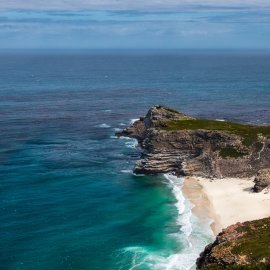The Political Edge
-
English
-
ListenPause
[intro music] Welcome to World Ocean Radio… I’m Peter Neill, Director of the World Ocean Observatory. As we continue our thematic overview of the edge between land and sea, let’s examine that defining line as a running continuum of political interests, defined by national borders, 12 mile offshore limits, and exclusive economic zones. The CIA World Fact Book estimates the total length of the world’s coasts combined equals 1,162,306 kilometers (or 722,223 miles). The World Resource Institute suggests a longer total, (1,634,701 kilometers) primarily as a result of a calculation based on a smaller scale that reveals and measures the coastal variations not included in the estimate at the larger scale. The closer we look at the myriad inroads, inundations, and openings that comprise the coast, the more extended and convoluted and complicated it becomes. With the overlay of national political interests, that line become even more truncated and conflicted by goals and objectives that may have nothing specifically to do with ocean interests. Let’s take for example the Benguela Current that runs along the southwest coast of Africa off shore from Angola, Namibia, and South Africa – a large marine ecosystem encompassing coastal river basins and estuaries with offshore ocean, over 200,000 square kilometers of area, defined by undersea topography, the productivity of its fisheries, and the make-up of their natural food chain. Across the globe, 80 percent of the global marine fisheries catch comes from such ecosystems. Each of the three nations has very clear political boundaries and territorial claims that overlap within the natural area. Political relations between the three have been troubled and collaborative interests not necessarily shared. How do you manage such coherent natural phenomenon within the context of political uncertainty? In 1994, The Global Environment Facility, an international funding agency, supported a series of research and planning studies to explore and understand the deteriorating situation for fisheries and the need for coordinated management. In 2007, the three nations created a new, ecosystem-based, Benguela Current Commission, the first Large Marine Ecosystem commission in the world, that has put in place managers, scientists, and administrators, to oversee the study, protection, and renewal of the integrated ocean space independent of politics, blurring the political edge for the benefit of the contiguous natural resource. Another example of political lines drawn in the ocean are the many conflicting islands and atolls in the South China Sea that involve disputes over territorial claims between China and Taiwan, Brunei, Malaysia, Indonesia, the Philippines, Vietnam, and Japan over the right of free navigational passage for more than US$5 trillion in global annual trade, as well as blatant extension of national control into traditional international waters. What once were simply geographical hazards to be avoided are filled with imported sand and rock to become a makeshift harbor for security vessels or a runway for military aircraft. The United States objects to these claims in that it upsets and narrows the corridors of power; suddenly ships presumably operating in the open ocean find themselves caught in a mesh of changing boundaries along a shifting political edge and there are geopolitical declarations that call for strategic response against constriction of influence. It must be remembered that these lines are not just drawn on the surface of the sea, but descend down also to become delimitation on the ocean floor. Those submerged areas have newly discovered value in the fish, oil, gas, minerals, and other submarine resources that are now to be recovered by improved technology and market demand. The political edge defines what can be newly exploited, one major calculation in the definition of power and a challenge to any program of international protection. And finally there is the application and enforcement of international agreements and treaties such as the Law of the Sea that pertain to areas beyond national jurisdiction. What is inside an arbitrary political line is one thing, what is outside is another, and, if we are to protect and conserve the ocean into the future, we must focus even more on that area on the other side of these invisible boundaries, by far the vast majority of the vast area of the ocean over which we have no specific control, that dynamic inter-soluble, ever-circulating volume of water that in fact, in its harsh reality, cares not a wit for our marks of possession and national pride, not a bit for what we call a political edge. The ocean knows no line it cannot cross; no edge it cannot challenge by its natural power and indifference finally to the land and to the petty aspirations who those who live there. We will discuss these issues, and more, in future editions of World Ocean Radio. [outro music]
We continue our thematic overview of the ocean edge this week with a conversation centered around coastal and offshore zones and the politics that define them. The Political Edge is part 6 of a 7-part series dedicated to the ocean edge, exploring what takes place there, from the real to the symbolic.
About World Ocean Radio
World Ocean Radio provides coverage of a broad spectrum of ocean issues from science and education to advocacy and exemplary projects. World Ocean Radio, a project of the World Ocean Observatory, is a weekly series of five-minute audio essays available for syndicated use at no cost by college and community radio stations worldwide.
Image
Cape of Good Hope. Cape Town, South Africa
Photo by Victor Smits on Unsplash
Resources from this Episode
- Benguela Current Commission
- Conflict in the South China Sea
- Law of the Sea (UNCLOS)
- Login to post comments



